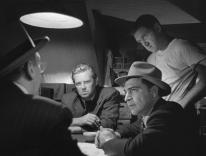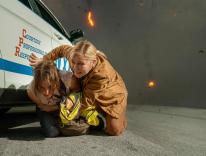The online “Urban Dictionary” tells me that a “hurt locker” is (1) an unfamiliar place where you wake up after a night of drunkenness; (2) a figurative place representing a tortured state of mind; and (3) an actual place where damaging things are concealed. Though the first definition fits the raunchy comedy The Morning After, the last two perfectly convey the substance of Kathryn Bigelow's brilliant Iraq combat film.
For Sergeant J. T. Sanborn (Anthony Mackie) and Specialist Owen Eldridge (Brian Geraghty), Iraq in the year 2004 is one big torture chamber, where heat, flies, dryness, sand, and—most of all—a resentful, ravaged population are dedicated to making their lives a 24/7 misery. The soldiers are the back-up for the leader of their three-man bomb squad. The leader is a bomb dismantler, and whenever he approaches an area where an improvised explosive may be planted, Sanborn and Eldridge move into whatever position will allow them to protect him. The enemy is nowhere and everywhere, for the bomber may be long gone or one of the many onlookers on balconies or at second-floor windows, ready to set the bomb off with a cell phone. Most of the townspeople are merely curious or fearful or fascinated, but the soldiers, given the task at hand, must see murder in every stare. They have been ordered to protect the civilians, but they have only one another to protect them from the civilians. In the very first scene, Sanborn and Eldridge, admirably trying not to be trigger-happy, refrain from shooting a nice-looking chap with a cell phone. He presses a button and their squad leader is dead.
And then the real fun begins. The dead man's replacement, Staff Sergeant Will James (Jeremy Renner), is profoundly good at his job. And dauntless. And clear-headed. And tenacious. And convivial. And funny. And compassionate. And a closet maniac who may get the entire team killed in the last thirty days of their tour of duty. When Mark Antony screamed, “Let slip the dogs of war,” he had the likes of Sergeant James in mind.
The film's epitaph, a quotation from reporter Chris Hedges that reminds us that war can be narcotic, is perfectly illustrated by James. The script doesn't pinpoint the cause of James's addiction, but it's clear from the start that life has savor for this man only when he's in the vicinity of death. His “hurt locker” is a literal footlocker holding bomb scraps that might have killed him were it not for his skills. The very brave and very sane Sanborn sneers at the collection as nothing but “spare parts from Radio Shack,” but to James these fragments are holy relics, totemic objects that he caresses and contemplates the way a South Seas warrior might pray to the mummified body parts of a fallen foe.
Sanborn and Eldridge never kid themselves about James, even as they admire his skill and courage. At one point, they even consider murdering him in order to save their own lives. But a few scenes later, all three are getting drunk with comradely gusto (a gusto somewhat qualified by Sanborn's putting a knife to James's throat), and, near the end of the movie, Sanborn is tearfully confessing his deepest fears and most poignant hope for the future while the bomb expert listens sympathetically. He is a man for all seasons, this James, but if he keeps feeding his addiction, he may ensure that his mates will never see another season back home. Remember Danny Glover's exasperation at Mel Gibson's death-inviting stunts in Lethal Weapon? Well, The Hurt Locker is the real Lethal Weapon.
The script by Mark Boal (who has been embedded with Iraqi forces) is unfussily humane and complex in its depiction of the way soldiers abide or don't abide one another during pockets of peace and boredom, but its construction of three-dimensional characters gives director Kathryn Bigelow all the more incentive to lead them in the direction of slaughter. The more we care, the closer we get to the edge of our seats. She accomplishes this with a realism that is both microscopic and kaleidoscopic. Consider the scene in which the bomb squad is pinned down by sniper fire coming from an abandoned building at the edge of a desert. Bigelow and her superb cinematographer, Barry Ackroyd, get so close to Sanborn's face as he trains his sights on the enemy that we can feel the torment inflicted on his eyelashes by flies and sand. But just as we are becoming locked into his misery, there is a cut to the point of view of the snipers. Of course, our sympathies don't shift with the camera angle, but it's unnerving that hunter becomes prey, then hunter again, as we go back and forth between the combatants. The editing, which constantly undermines our sense of security without ever sacrificing visual clarity, is so important to the director's aims that the editors, Chris Innis and Bob Murawski, might be considered cocreators of the film.
In her use of the star system, and the confidence we unconsciously place in it, Bigelow is downright fiendish. Having hired relatively little-known actors for the leads, she then coaxed more familiar ones, Ralph Fiennes and Guy Pearce, into supporting roles—and proceeded to kill them off! Thus the director ratchets up the suspense. If she dispatches a star like Fiennes, our instincts tell us, won't she be just as ruthless with Renner and Mackie? Aren't these characters doomed?
In fact, viewing The Hurt Locker was such a white-knuckle experience that I couldn't help wondering what the movie would be like once I knew the fate of the protagonists. Wouldn't a second viewing seem limp in comparison with the first? I went back to find out and discovered the movie just as good but different, a character study instead of an action flick. The action sequences themselves complicate character. The scene in which James forces an Iraqi peddler to take him into a neighborhood at night so that he can find out what happened to a child he befriended and now fears dead is a nightmare of suspense. The first time I saw it, I knew it revealed the hero's basic craziness as well as his equally basic compassion, but it was only the second viewing that made me wonder if the soldier was plunging into hell for the sake of the boy or merely as an excuse for indulging his taste for danger. The ironic epilogue to the episode reinforced my suspicion.
The three leads couldn't be better. Anthony Mackie soaks Sanborn's basic decency in a corroding acid of desperation. Brian Geraghty's Eldridge is a study of sanity almost undermined by the spins war gives to Dame Fortune's wheel. If The Hurt Locker makes any of its actors a star, it will be Jeremy Renner, not because he is better than the others but because the man he plays sticks in our craw. Sanborn and Eldridge are civilization under fire. James is the indispensable fly in civilization's ointment. Watching Renner slowly reveal James's unsettling heroism, I was reminded of Stanley Kauffmann's reaction to Albert Finney's first star turn in Saturday Night and Sunday Morning: “His face is not an outstandingly good actor's mask.... But he forces his way ahead, carrying his fairly dead pan before him.... He has what might be called resident power; his presence continues effortlessly while he is on camera, without mugging or distracting from his fellow actors.” All true of Renner.
It was clear from such entertainments as Strange Days, Blue Metal, and After Dark that Kathryn Bigelow could churn emotions on screen and in the audience, but she didn't seem to know that her scripts were overstuffed, garish, and in need of a director who could dry them out instead of jazzing them up. Now, in The Hurt Locker, Bigelow's flair for violence and suspense marries scriptwriter Mark Boam's capacity for tough compassion. The result is a major film.
Please email comments to [email protected] and join the conversation on our Facebook page.
Previous Story
Do Women Have Souls?
Next Story
Nature's Cathedrals


